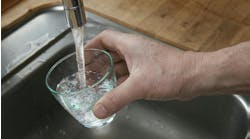DOWNERS GROVE, ILL. — The topic of alternate water sources was a significant focus of the Green Technical Committee of the International Association of Plumbing & Mechanical Officials. The GTC met here in late August as it refines the latest edition of its Green Plumbing & Mechanical Code Supplement (GPMS).
Non-potable water received considerable attention. Inside buildings, the GPMS requires bathrooms to have signs stating that they are using alternate water sources. The sign must state that the building uses “X” to flush toilets and urinals, with whatever “X” is being the source of the water source, such as municipal reclaimed water or rainwater. To protect the contractor or service tech, the mechanical room has to contain signage stating which equipment contains non-potable water.
The GPMS will continue to ban use of rainwater collected from parking lots, bodies of standing water or surface water runoff. The reason, explained Dave Viola, IAPMO’s director of special services, is to protect rainwater catchment systems, which harvest water that is essentially pure. Water from other sources will contain contaminants and should be put through an onsite water treatment system before it can be used.
The GPMS mentions “above ground man-made collection surfaces.” What does that mean? That’s good question for the public comment period, Viola said. Could it be the roof of a garage? A sloping piece of plywood?
The GPMS, attempting to harvest any water that might otherwise go down the drain, mentions collecting and reusing water from food steamers or industrial process water. It also tackles “dry weather runoff,” a concept that sparked debate over what it could include and how it should be defined.
It was agreed that dry weather runoff is water that flows along a surface; questions centered around what the source could be and whether those sources should be exhaustively listed or if the definition should be simple.
Viola said dry weather runoff could come from irrigation runoff or water from a carwash. Gary Klein, Affiliated International Management LLC, suggested hydrant flushing as a source. Engineer Bill Hoffman, HW Hoffman & Associates, pointed out that some jurisdictions are already capturing it and treating it. Viola suggested striking the words “not from rain” so the definition would include all water that flows along a surface, but committee members saw problems with that. What if, posited Julius Ballanco, JB Engineering & Code Consulting, the flowing water came from snowmelt that occurred months after the snow occurred? Is that dry weather runoff? Finally, engineer Tom Meyer, Praxis Green, said the definition should say it’s any water not from precipitation.
The issue of “laundry lists” came up more than once. If the code includes language such as, “… but not limited to …” authorities having jurisdiction often don’t read that far.
Alternate water sources are numerous: condensate from air conditioners or steam-producing equipment, foundation drain water, parking lot runoff and even blackwater. All of them require various levels or treatment before they can be re-used. For water that’s going to be sprayed in the air — car washes, fountains, irrigation and the like — such systems need to filter out debris and particulates, contain less than 100 colony forming units of E. coli per 100 mL, and turbidity of less than 10 Nephelometric Turbidity Units. Blackwater needs full scale sewage treatment systems, either onsite or off.
The committee tried to strike a balance between public safety and making the use of alternative water sources a hassle. Viola pointed out that the GPMS is a binding legal document if somebody gets sick because of a non-potable water source. At the same time, noted Edward Osann of the Natural Resources Defense Council, the committee doesn’t want to discourage a homeowner who might want to install a 300-gal. rainwater harvesting system for irrigation.
Engineer E.W. “Bob” Boulware, Design-Aire Engineering, Inc., and a past president of the American Rainwater Catchment Systems Association, suggested that requiring testing of rainwater systems every three months was too onerous. He suggested 12 months, a motion approved by the committee.
Also debated in the committee and likely by the public commenters is who should design alternative water sources? Who should install them? Would the mandates of the authority having jurisdiction trump anything they put in the GPMS? And any provisions the committee puts in the GPMS may be picked apart of different jurisdictions.
The Green Supplement has been released for its 45-day public review period. After that, IAPMO staff will put all of the comments and proposed changes in a matrix and prepare it for consideration at the next scheduled meeting. The GTC will meet in Ontario, Calif., Dec. 8-9. The latest edition is expected to hit the streets in early 2012.
Related Articles:
IAPMO GTC finalizes green supplement
Related Articles:
Green codes advance water conservation goals

